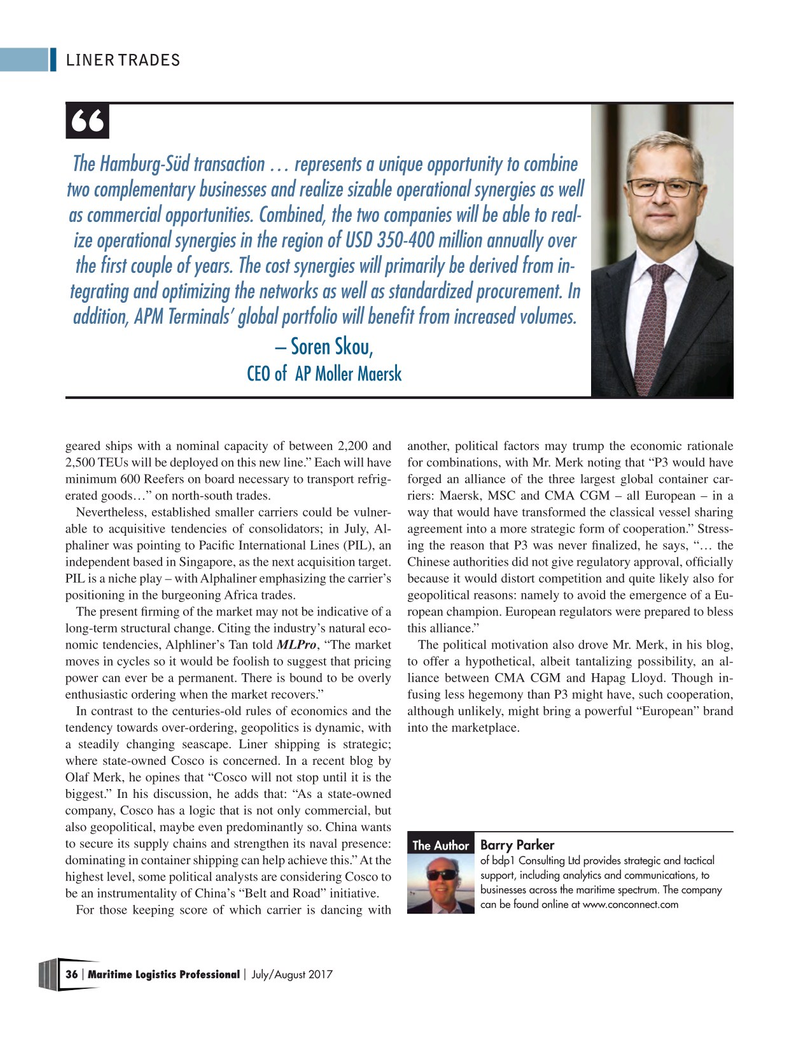
Page 36: of Maritime Logistics Professional Magazine (Jul/Aug 2017)
PORTS & INFRASTRUCTURE
Read this page in Pdf, Flash or Html5 edition of Jul/Aug 2017 Maritime Logistics Professional Magazine
LINER TRADES
The Hamburg-Süd transaction … represents a unique opportunity to combine two complementary businesses and realize sizable operational synergies as well as commercial opportunities. Combined, the two companies will be able to real- ize operational synergies in the region of USD 350-400 million annually over the frst couple of years. The cost synergies will primarily be derived from in- tegrating and optimizing the networks as well as standardized procurement. In addition, APM Terminals’ global portfolio will beneft from increased volumes.
– Soren Skou,
CEO of AP Moller Maersk geared ships with a nominal capacity of between 2,200 and another, political factors may trump the economic rationale 2,500 TEUs will be deployed on this new line.” Each will have for combinations, with Mr. Merk noting that “P3 would have minimum 600 Reefers on board necessary to transport refrig- forged an alliance of the three largest global container car- erated goods…” on north-south trades. riers: Maersk, MSC and CMA CGM – all European – in a
Nevertheless, established smaller carriers could be vulner- way that would have transformed the classical vessel sharing able to acquisitive tendencies of consolidators; in July, Al- agreement into a more strategic form of cooperation.” Stress- phaliner was pointing to Pacifc International Lines (PIL), an ing the reason that P3 was never fnalized, he says, “… the independent based in Singapore, as the next acquisition target. Chinese authorities did not give regulatory approval, offcially
PIL is a niche play – with Alphaliner emphasizing the carrier’s because it would distort competition and quite likely also for positioning in the burgeoning Africa trades. geopolitical reasons: namely to avoid the emergence of a Eu-
The present frming of the market may not be indicative of a ropean champion. European regulators were prepared to bless long-term structural change. Citing the industry’s natural eco- this alliance.” nomic tendencies, Alphliner’s Tan told MLPro, “The market The political motivation also drove Mr. Merk, in his blog, moves in cycles so it would be foolish to suggest that pricing to offer a hypothetical, albeit tantalizing possibility, an al- power can ever be a permanent. There is bound to be overly liance between CMA CGM and Hapag Lloyd. Though in- enthusiastic ordering when the market recovers.” fusing less hegemony than P3 might have, such cooperation,
In contrast to the centuries-old rules of economics and the although unlikely, might bring a powerful “European” brand tendency towards over-ordering, geopolitics is dynamic, with into the marketplace.
a steadily changing seascape. Liner shipping is strategic; where state-owned Cosco is concerned. In a recent blog by
Olaf Merk, he opines that “Cosco will not stop until it is the biggest.” In his discussion, he adds that: “As a state-owned company, Cosco has a logic that is not only commercial, but also geopolitical, maybe even predominantly so. China wants to secure its supply chains and strengthen its naval presence:
Barry Parker
The Author of bdp1 Consulting Ltd provides strategic and tactical dominating in container shipping can help achieve this.” At the support, including analytics and communications, to highest level, some political analysts are considering Cosco to businesses across the maritime spectrum. The company be an instrumentality of China’s “Belt and Road” initiative. can be found online at www.conconnect.com
For those keeping score of which carrier is dancing with 36 Maritime Logistics Professional July/August 2017 | |

 35
35

 37
37
